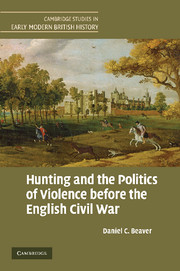Book contents
- Frontmatter
- Contents
- List of maps
- Acknowledgments
- List of abbreviations
- Introduction: Hunting, violence, and the origins of the English Revolution
- 1 Blood, sacrifice, and order: meanings of the forest and hunt in culture, politics, and society
- 2 Honor, property, and the symbolism of the hunt in Stowe, 1590–1642
- 3 Ancient liberties and the politics of the commonweal in Waltham Forest, 1608–1642
- 4 Royal honor, great parks, and the commonweal in Windsor Forest, 1603–1642
- 5 Venison and the politics of honor in Corse Lawn Chase, 1620–1642
- Conclusion: Royal symbols, forest politics, and popular politics in early modern England
- Bibliography
- Index
- Titles in the series
1 - Blood, sacrifice, and order: meanings of the forest and hunt in culture, politics, and society
Published online by Cambridge University Press: 06 March 2010
- Frontmatter
- Contents
- List of maps
- Acknowledgments
- List of abbreviations
- Introduction: Hunting, violence, and the origins of the English Revolution
- 1 Blood, sacrifice, and order: meanings of the forest and hunt in culture, politics, and society
- 2 Honor, property, and the symbolism of the hunt in Stowe, 1590–1642
- 3 Ancient liberties and the politics of the commonweal in Waltham Forest, 1608–1642
- 4 Royal honor, great parks, and the commonweal in Windsor Forest, 1603–1642
- 5 Venison and the politics of honor in Corse Lawn Chase, 1620–1642
- Conclusion: Royal symbols, forest politics, and popular politics in early modern England
- Bibliography
- Index
- Titles in the series
Summary
And some certain significance lurks in all things, else all things are little worth, and the round world itself but an empty cipher …
Herman Melville, Moby Dick (1851)In 1618, Horatio Busino, a chaplain to the Venetian ambassador, famously described the highest form or “very noble manner” of royal hunt in England under James I, “when his majesty chooses to hunt without taking any advantage” of the stag in firearms or in wounding before the chase. After a prolonged pursuit, the king approaches the dead stag,
dismounts, cuts its throat, and opens it, sating the dogs with its blood as reward of their exertions. With his own imbrued hands, moreover, he is wont to regale some of his nobility by touching their faces. This blood it is unlawful to remove or wash off, until it fall of its own accord, and the favored individual thus bedaubed is considered to be dubbed a keen sportsman and chief of the hunt and to have a certificate of his sovereign's cordial good will.
In 1655, Margaret Cavendish observed the purifying powers ascribed to this blood in “a usual custom for ladies and women of quality, after the hunting a deer, to stand by until they are ripped up, that they might wash their hands in the blood, supposing it will make them white.” These ritual uses of deer blood both conveyed and expressed a quality of human blood.
- Type
- Chapter
- Information
- Publisher: Cambridge University PressPrint publication year: 2008



